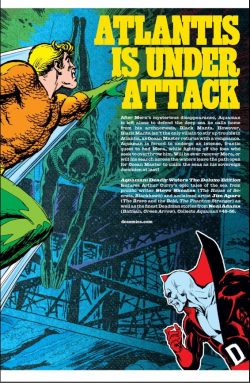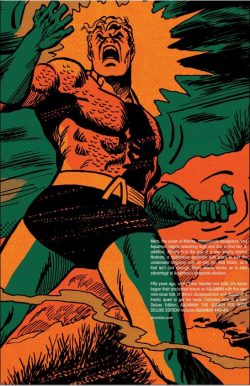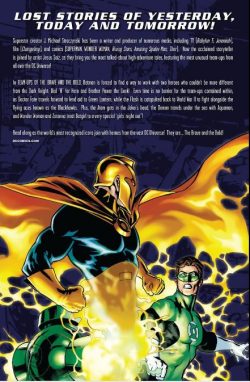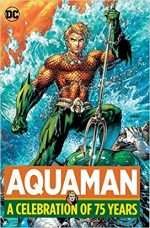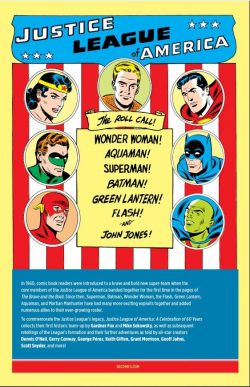
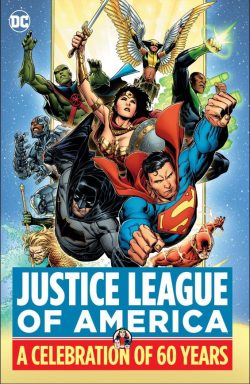
By Gardner Fox, Dennis O’Neil, Steve Englehart, Gerry Conway, Keith Giffen, J.M. DeMatteis, Grant Morrison, Mark Waid, Brad Meltzer, Geoff Johns, Scott Snyder, Mike Sekowsky, Dick Dillin, George Pérez, Pat Broderick, Carmine Infantino, Jim Aparo, Dick Giordano, Gil Kane, Brian Bolland, Joe Kubert, Chuck Patton, Kevin Maguire, Howard Porter, Ed Benes, Jim Lee, Jim Cheung & various (DC Comics)
ISBN: 978-1-4012-9951-4 (HB)
Win’s Christmas Gift Recommendation: Comic Perfection and the ideal Stocking Stuffer… 10/10
A keystone of the DC Universe, the Justice League of America is the reason we have comics industry today. This stunning compilation – part of a series reintroducing and exploiting the comics pedigree of veteran DC icons and concepts – is available in hardback and digital formats and offers a too-brief but astoundingly enticing sequence of snapshots detailing how the World’s Greatest Superheroes came to be, and be and be again…
Collecting material from The Brave and the Bold #28; Justice League of America #29, 30, 77, 140, 144, 200; Justice League of America Annual #2, Justice League #1, 43 and Justice League of America volume 4 #1 (covering July 1960- August 2018), the landmarks selected are all preceded by a brief critical analysis of the significant stages in their development, beginning with Part I – 1960-1964: The Happy Harbor Years …
After the actual invention of the comicbook superhero – by which we mean the launch of Superman in June 1938 – the most significant event in the industry’s progress was the combination of individual sales-points into a group. Thus, what seems blindingly obvious to everyone with the benefit of four-colour hindsight was irrefutably proven – a number of popular characters could multiply readership by combining forces. Plus of course, a whole bunch of superheroes is a lot cooler than just one – or even one and a sidekick…
The Justice Society of America is rightly revered as a true landmark in the development of comic books, and – when Julius Schwartz began reviving and revitalising the nigh-defunct superhero genre in 1956 – the true key moment came a few years later with the inevitable teaming of his freshly reconfigured mystery men…
When wedded to the relatively unchanged big guns who had weathered the first fall of the Superhero at the beginning of the 1950s, the result was a new, modern, Space-Age version of the JSA and the birth of a new mythology.
That moment that changed everything for us baby-boomers came with issue #28 of The Brave and the Bold, a classical adventure title that had recently become a try-out magazine like Showcase.
Just in time for Christmas 1959, ads began running…
“Just Imagine! The mightiest heroes of our time… have banded together as the Justice League of America to stamp out the forces of evil wherever and whenever they appear!â€
When the Justice League of America was launched in issue #28 of The Brave and the Bold (March 1960) it cemented the growth and validity of the genre, triggering an explosion of new characters at every company producing comics in America and even spread to the rest of the world as the 1960s progressed.
Crafted by Gardner Fox & Mike Sekowsky with inking from Bernard Sachs, Joe Giella & Murphy Anderson, ‘Starro the Conqueror!’ saw Flash, Green Lantern, Wonder Woman, Aquaman and J’onn J’onzz – Manhunter from Mars unite to defeat a marauding alien starfish whilst Superman and Batman stood by (in those naive days editors feared that their top characters could be “over-exposed†and consequently lose popularity). The team also picked up an average American kid as a mascot. “Typical teenager†Snapper Carr would prove a focus of fan controversy for decades to come…
The series went from strength to strength and triumph to triumph, peaking early with a classic revival as the team met the Justice Society of America, now sensibly relegated to an alternate Earth rather callously designated Earth-2.
From issues #29-30, ‘Crisis on Earth-Three’ and ‘The Most Dangerous Earth of All!’ reprise the first groundbreaking team-up of the JLA and JSA, after the metahuman marvels of yet another alternate Earth discover the secret of multiversal travel. Unfortunately, Ultraman, Owlman, Superwoman, Johnny Quick and Power Ring are ruthless villains from a world without heroes who see the costumed crusaders of the JLA and JSA as living practice-dummies to sharpen their evil skills upon…
With this cracking 2-part thriller a tradition of annual summer team-ups was solidly entrenched in heroic lore, giving fans endless joys for years to come and making the approaching end of school holidays less gloomy than they could have been.
Although a monster hit riding a global wave of popularity for all things masked and caped, the JLA suffered like all superhero features when tastes changed as the decade closed. Like all the survivors, the team adapted and changed…
A potted history of that interregnum, emphasising the contributions of iconoclastic scripters Denny O’Neil and Steve Englehart follows in Part II – 1969-1977: The Satellite Years after which groundbreaking issue #77 exposes a new kind of America.
America was a bubbling cauldron of social turmoil and experimentation at this time, with established beliefs constantly challenged and many previously cosy comics features were using their pages to confront issues of race, equality, and ecological decline. O’Neil and his young colleagues began to utterly redefine superhero strips with their relevancy-driven stories; transforming complacent establishment masked boy-scouts into uncertain, questioning champions and strident explorers of the revolution.
Here, the team’s mascot suddenly grows up and demands to be taken seriously. The drama commences with the heroes’ collective confidence and worldview shattered as enigmatic political populist Joe Dough suborns and compromises their beloved teen sidekick in ‘Snapper Carr… Super-Traitor!’ Crafted by O’Neil, Dick Dillin & Joe Giella, the coming-of age-yarn changed the comfy, cosy superhero game forever…
By March 1977, the team was back in traditional territory but still shaking up the readership. Issue #140, by Steve Englehart, Dick Dillin & Frank McLaughlin questioned heroism itself in ‘No Man Escapes the Manhunter!’ as the venerable Guardians of the Universe and their beloved Green Lanterns are accused of planetary extinctions – until the JLA expose a hidden ancient foe determined to destroy galactic civilisation…
Sadly, all you get here is the opening chapter, but it’s worth tracking down the entire saga elsewhere…
Closely following is issue #144 ‘The Origin of the Justice League – Minus One!’ (July 1977) by the same team. Here Green Arrow does a little checking and discovers the team have been lying about how and why they first got together: a smart and hugely enjoyable conspiracy thriller guest-starring every late 1950’s star in the DC firmament…
Change is a comic book constant and events described in the essay fill in crucial context before Part III: The Detroit Years 1982-1987 precis’ the first Beginning of the End for the World’s Greatest Superheroes, starting with blockbuster anniversary giant #200.
Here scripter Gerry Conway and artists George Pérez, Pat Broderick, Carmine Infantino, Jim Aparo, Dick Giordano, Gil Kane, Brian Bolland, Joe Kubert, Brett Breeding, Terry Austin & Frank Giacoia reprise, re-evaluate and relive the alien Appellax invasion that brought the heroes together in ‘A League Divided’: a blockbuster saga involving every past member…
Big changes began in Justice League of America Annual #2 1984. ‘The End of the Justice League!’ by Conway, Chuck Patton & Dave Hunt saw the team disband following a too-close-to-call alien attack, leading Aquaman to recruit a squad of full-time agents rather than part-time champions. Relocating to street level in Detroit, his old guard veterans Elongated Man, Martian Manhunter, Zatanna and Vixen also began training a next generation of costumed crusaders…
The biggest innovation came after a couple of publishing events recreated the universe and a new kind of team was instituted. In 1986 DC’s editorial leaders felt their 50-year continuity was stopping them winning new readers. The solution was a colossal braided-mega series to streamline, redefine and even add new characters to the mix.
The worlds-shattering, reality-altering bombast of Crisis on Infinite Earths was such a spectacular commercial success, those movers-&-shakers felt more than justified in revamping a number of their hoariest icons for their next fifty years of publishing. As well as Superman, Flash, and Wonder Woman, the moribund and unhappy Justice League of Americawas earmarked for a radical revision. Editor Andy Helfer assembled plotter Keith Giffen, scripter J.M. DeMatteis and untried penciller Kevin Maguire to produce an utterly new approach to the superhero monolith: they played them for laughs…
The series launched as Justice League with a May 1987 cover-date before retitling itself as Justice League International with #7. The new team was formed from the ashes of the old on the basis of events comprising follow-up crossover-event Legends. The gathering comprised a roster of relative second-stringers as America’s newest champions – Black Canary, Blue Beetle, Captain Marvel (now Shazam!), Dr. Fate, Green Lantern Guy Gardner and Mr. Miraclewith heavyweights Batman and Martian Manhunter J’onn J’onzz as nominal straight-men.
The first story introduced charismatic filthy-rich manipulator Maxwell Lord – who used wealth and influence to recreate the neophyte and rather shambolic team who started their march to glory by fighting and defeating a bunch of rather inept terrorist bombers in initial outing ‘Born Again’ (Giffen, DeMatteis Maguire & Terry Austin).
An eventful decade passed and the team were rebooted again, as described in Part IV: The Watchtower Years 1986-2003
After the Silver Age’s greatest team-book died a slow, painful, wasting death, not once but twice, DC were taking no chances with their next revival of the Justice League of America, tapping Big Ideas wünderkind Grant Morrison to reconstruct the group and the franchise.
The result was a gleaming paradigm of comic book perfection which again started magnificently before gradually losing the attention and favour of its originally rabid fan-base. Apparently, we’re a really fickle and shallow bunch, us comics fans…
That idea that really clicked? Put everybody’s favourite Big-Name superheroes back in the team.
It worked, but only because as well as name recognition and star quantity, there was a huge input of creative quality. The stories were smart, fast-paced, compelling, challengingly large-scale and drawn with effervescent vitality. With JLA you could see all the work undertaken to make it the best it could be on every page.
The drama begins in ‘Them!’ (January 1997 by Morrison, Howard Porter & John Dell) as a family of alien super-beings called the Hyperclan dramatically land on Earth and declare that they’re going to usher in a new Golden Age – at least by their standards.
Almost simultaneously the current iteration of the Justice League is attacked in their orbital satellite and only narrowly escape utter destruction. Tragically, one of their number does not survive…
Hyperclan’s very public promises to make Earth a paradise and attendant charm offensive does not impress veteran heroes Superman, Batman, Wonder Woman, Martian Manhunter and Aquaman or even the latest incarnations of Flash and Green Lantern.
These legends see their methods and careers questioned and are not impressed by seeming miracles or summary executions of super-criminals in the streets. They know there’s something not right about the overbearing sanctimonious newcomers…
The hits kept coming: a strung of superb adventures that enticed the readership. One of the very best and often cited as one of the best Batman stories ever created, multi-part paean to paranoia Tower of Babel saw immortal eco-terrorist Ra’s Al Ghul‘s latest plan to winnow Earth’s human population to manageable levels well underway. Again, only the first instalment is here but you know where else to look…
Issue #43 declared ‘Survival of the Fittest’ (by Mark Waid, Porter & Drew Geraci), as a series of perfectly planned pre-emptive strikes cripple Martian Manhunter, Flash, Wonder Woman, Aquaman, Plastic Man and Green Lantern whilst Batman is taken out of the game by the simple expedient of stealing his parents’ remains from their graves…
Comics stars increasingly became multi-media franchises at the beginning of this century, and Part V: The Crisis Years 2006-2011 acknowledges the change as the printed form started a constant stream of ever-escalating blockbuster scenarios to compete. A perfect example is Justice League of America volume 4 #1 (October 2006) as Brad Meltzer, Ed Benes & Sandra Hope examine ‘Life’.
Thanks to the events Infinite Crisis, One Year Later and 52, Superman, Batman and Wonder Woman convene as a star-chamber to reform the Justice League of America as a force for good, only to discover that events have escaped them and a new team has already congealed (I really can’t think of a better term) to defeat the imminent menace of Professor Ivo, Felix Faust and the lethal android Amazo, plus a fearsome mystery mastermind and a few classic villains as well.
The tale is told through the heartbreaking personal tragedy of the Red Tornado, who achieves his deepest desire only to have it torn from him: an enjoyable if complex drama that hides its true purpose – that of repositioning the company’s core team in an expanded DCU which encompasses all media, tacitly accepting influences from TV shows, movies and animated cartoons underpinning everything – even the Super Friends and Justice League Unlimited-inspired HQ.
In 2011, DC took a draconian leap: restarting their entire line and continuity with a “New 52â€. Justice League volume 2 #1 (November) led from the front as ‘Justice League Part One’ by biggest guns Geoff Johns, Jim Lee & Scott Williams introduced a number of newly debuted heroes acrimoniously pulled together to fight an alien invader called Darkseid…
This celebration concludes with Part VI: The Media Era 1986-2018 and Justice League volume 4 #1 (August 2018) wherein Scott Snyder, Jim Cheung & Mark Morales kick off a colossal, years-long company-wide event. ‘The Totality Part 1’ sees the universe fall apart, its creator escape eternal imprisonment and the JLA hard-pressed to prevent the final triumph of Evil as represented by Lex Luthor and his Legion of Doom…
Adding immeasurably to the wonderment is a superb gallery of covers by Sekowsky, Anderson, Rich Buckler, Dillin & McLaughlin, Pérez, Patton & Giordano, Maguire & Austin, Porter, Dell & Geraci, Ed & Mariah Benes, Lee & Williams and Jim Cheung.
The Justice League of America has a long, proud history of shaking things up and providing dynamic provocative, drama delivered with quality artwork. This compelling assortment is staggeringly entertaining and a monolithic testament to the inestimable value of a strong core concept matured over decades of innovation.
© 1960, 1964, 1969, 1977, 1982, 1984, 1987, 1997, 2000, 2006, 2005, 2011, 2018, 2020 DC Comics. All Rights Reserved.
